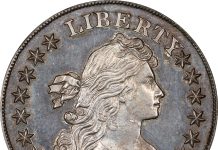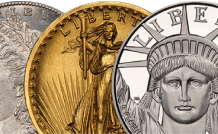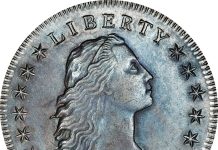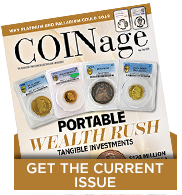*** EXCLUSIVE TO COINage ***
Preview of the Columbian Expo Collectibles Book
By Steve Starlust
Referencing Columbiana, my newly published book, is a reference on the medals, badges and souvenirs of the historic 1893 World’s Columbian Exposition event held in Chicago, which was dedicated to Christopher Columbus’ discovery of America. That “Chicago World’s Fair” attracted over 29 million visitors and it provided a wealth of medals for attendees and collectors.
Columbian Expo medals are often submitted for identification by experts and are returned improperly described. Part of the reason for this is that the literature often relied upon is outdated.
Referencing Columbiana was first released at the Georgia National Money Show held in Atlanta in February. The book references other published works that were well-received 60 years ago. There are over 350 medals that are described in depth for the first time. I provide 500 descriptions illustrated with 1,000 color pictures. Grades shown are from recognized grading services. Some of the images are enhanced, but the integrity of the designs will be as struck. This reference anthology is for dedicated Columbian Expo collectors.
My book has four sections. Section one contains medals, coins, key fobs and tickets. These are valued from $150 to $1,500. Focus is given to polished glass miniature 19mm to 29mm medals that are now highly sought after and are bringing strong prices at auctions. Silver box coins, associated with concealing opium, are illustrated.
I am fascinated by the unusual story of the Official Government Recognition Award Medals that fired up a feud between coin designers Augustus Saint-Gaudens and Charles Barber and the U.S. Senate Quadro- Centennial Committee that burned hotter than the famed Chicago fire. This large award medal displayed Columbus stepping forward from his vessel onto the rocky shore of the New World. He is adorned with armor, a long cloak, arms outspread and head raised to the sky. There were at least 800 medals produced and presented to a variety of people and businesses. Medals were minted by Scovill Manufacturing Company of Waterbury, Connecticut, and distributed in April 1896 along with a large certificate. This award medal was mandated by an act of Congress. They were allowed to be reproduced as replica promotional medals by special permission from the U.S. Treasury Department. Today, these award medals are valued from $300 to $500.
References and color images are given to the “United We Stand/ Liberty Head” series engraved by medalist Wilhelm Mayer of Germany and his compatriot Ernst Ludwig Siegmund Lauer. This ornate 90mm medal is shown in aluminum, bronze, white metal, gilt and silver to help collectors attribute metals. These are valued at $300 to $1,500 each.
The many contributions by Tiffany & Co. and Gorham are on full view, as are the many attractive designs of Lincoln engraver H. Zearing of Chicago. Attention is paid to the L. Pogliaghi medals. A lot of attention is paid to Exposition Committee President Harlow Higinbotham’s beautifully engraved recognition medals given out to designers, chiefs of departments, commissioners, boards of directors and officers of the Board of Lady Managers. They were personalized for recipients using pin-bars, dangles and ribbons.
An interesting series of large compressed black walnut wood souvenirs is fully shown, along with a page dedicated to the Colónes currency of Costa Rica. A monetary unit known as a Colon issued in 1896 as legal tender. They are the only gold coins Columbus has ever appeared on. These coins were produced in different denominations, by the United States mint in Philadelphia. These gold coins can be valued from $750 to $10,000.
Overviews of the only 8 Reales denominations issued by the Republic of Guatemala with a bust of the discoverer are shown. Only two are known to exist. I would estimate their value to be in the $5,000 range. A Meiji copper 1 Rin minted in Japan just for the World’s Columbian Exposition that has become one of Japan’s rarest coins sold at auction in 2011 for $63,250. My guess is that if this sold today it would go for double its 2011 price. There are also many types of perpetual calendar variations listed and shown.
Section two has new discoveries from all over the globe, store cards, 3-D fobs, key rings, stamping dies, commemoratives, brooches, jewelry, pinbacks and a section on the Expo Guards. Medals from Uruguay, Argentina, Italy, Spain, France and countries other than the United States are discussed.
Section three displays badges and ribbons distributed for Chicago Day, Manhattan Day, the highly collected state badges, silk and grosgrain polyester ribbons, specialty celluloid ribbons, dedication ceremony honorary badges produced for the boards of directors, department chiefs, Board of Lady Managers, officials and select honorees to wear at the dedication ceremonies held on Oct. 21, 1893. There are unique tributes to Exposition organizers and royalty in gold and silver as well as examples of Multi-Medals.
Section four has a sampling of very cool souvenirs, such as the Columbus needle, Columbus dominoes, tip trays, gold tone pins, celluloid buttons, full color metallic wall ornaments, brass decorations, snuff boxes, Vienna Art plates, lacquerware, milk plates and bass relief clay plates, door stops, Santa Maria pins and filigree brass & enameled brooches, Japanese vases, golden mantel clocks, drinkware, Copeland Spode stoneware, paperweights, fans, statues, and then some. The value range of these items range from $125 to $3,500.
Other highlights include elongateds, merchant issues and admission tickets. There are four pages of Stefano Johnson of Milan, Italy, issues and four pages for Russ Frank’s specialty 50-cent commemorative rarities showcased including filigree looped key chains with diamond inlays, pinback variations, hinged picture lockets, a love-token gallery and souvenir badges. There’s information about the designers, historical data, countries of origin and packaging. Any future editions will use the same reference numbers and may just have a few more pictures and perhaps some more special sections.
I am hoping more people will become enthusiasts of this grand 1893 gathering that attracted millions of visitors from the United States and around the world. This Expo was a symbol of emerging American exceptionalism and firsts for the future. The first ferris wheel, an attraction conceived and built by George W. Ferris exclusively for the Columbian Expo and displayed on many different medals, was among the featured.
Also introduced for the first time were Cracker Jack, Quaker Oats, Shredded Wheat, hot dogs, hamburgers, soda, Hershey’s Chocolate and belly dancing. Visitors to the fair paid 50 cents and kids under 12 paid half of that. It was well worth it to have the choice of so many exhibits on over 600 acres in Chicago’s Jackson Park. If you are a collector of “most complete,” you will now have more pieces to search for.
Recently, Columbian Expo collectibles have been seeing high prices for mint-state specimens and hard-to-find Columbus souvenirs from the event. It’s my hope that I can educate, inform and cultivate collectors of this important area of Americana.
WORLD’S COLUMBIAN EXPOSITION CELEBRATED THE 400TH ANNIVERSARY OF COLUMBUS’ DISCOVERY OF AMERICA
Christopher Columbus was a famous explorer and skilled navigator, born in Genoa, Italy, in 1451. He is credited with “discovering” the Americas, known as the New World, in 1492. Many believe his journeys marked the beginning of centuries of exploration and colonization of North and South America. His ships, known then as caravels, were the Niña, Pinta and Santa Maria. The Spanish monarchy, specifically King Ferdinand II and Queen Isabella I, played an important role in Columbus’s voyages by providing funding and support for his expeditions.
The World’s Columbian Exposition was a major international exposition held in Chicago in 1893 to commemorate the 400th anniversary of Columbus’ landing in the New World. The fair, held in Jackson Park on Chicago’s South Side, showcased global diversity, culture, architecture, industry, and innovation. The Exposition ran from May 1 to October 31, 1893. It influenced America’s city planning, the development of amusement parks, and the creation of Columbus Day as a national holiday. A stunning array of artistic and architectural talent was recruited to design the fair’s main, palatial exhibition buildings on highly landscaped grounds, envisioned to become a public park that would rival Central Park in New York City.
There were hundreds of attractions that included major buildings such as the administration, the agricultural, the electrical, horticultural, fisheries, machinery hall, transportation building, and the European ethnological villages featured in the midway. The world’s first Ferris wheel was built along with many other firsts to the world, and many medals, badges, and souvenir collectibles were created as a result of this extravaganza.
Steve Starlust authored a book on the medals, badges and souvenirs of the 1893 World’s Columbian Expo. To order Referencing Columbiana, contact the author via e-mail at stevestarlust@gmail.com or phone at (631) 374-4483. List price is $75, but COINage readers will pay a special price of $65 for one and $55 each for two or more. Prices include shipping and handling.












